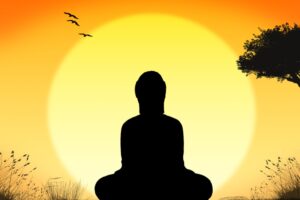September 2009

Having just completed the first edition of a manual requested by members, “Zen Practice at Home,” it seems appropriate to add some comments about the importance of home practice that were not covered in the manual.
This message is not specifically directed to a Zen Syndrome. But it is related to the idea that enlightenment, or spiritual awakening, is something that is not at hand, but a treasure we must pursue on pilgrimage—in foreign lands, at exotic locations, or, most desirably, surrounded by nature at its most beautiful—preferably in a resort-like setting.
In Soto Zen, we encourage lay practitioners to let Zen practice come into their lives in a natural way, not to make it artificial. As Matsuoka-roshi would say, the Zen person is happy with ordinariness. But of course everybody’s “ordinary” is slightly different.
It is also a premise of Buddhism that the true home is found in homelessness, just as the true self is found in selflessness
Zenkai Taiun Michael elliston, roshi
Thus, there is no set formula that the pursuit of Zen meditation, study, and application to daily life that can be prescribed for everyone, except in the most general terms. Most folks today seem to arrive at a similar kind of pattern, such as sitting a half hour to an hour a day, in the morning and evening or both, before and after the day’s activities. In addition, many attend group practice at the Zen center once a week, and a longer retreat once a year or so. This seems to be a kind of basic minimum to ensure that the effects of zazen, and the momentum of practice, are not diluted. However, this may not work for a given individual. Depending on the circumstances in which one finds oneself, it may be turn out to be too much, or too little.
By and large, as Matsuoka-roshi often said (though of course he never said “by and large”), the more you sit, the more you want to sit. This does not mean that zazen grows into an obsession, taking the place of one’s normal daily activities. But the resistance that one may feel in the beginning gradually diminishes over time, until sitting in zazen becomes as natural a part of one’s daily routine as brushing teeth, or sleeping.
An individual may begin exploring meditation by practicing at home, commonly after reading a book about it. Or, the person may come to a Zen center to try it for the first time. In each case, they may be vaguely aware of the other approach, but not sure how to go about it. In the case of home practice, one needs some minimal amount of equipment, such as a cushion, and some idea of the process to get started. In the case of group practice at a Zen center, one needs to know where it is and to be able to get there in person.
Both kinds of experience are important, but both are very different, especially in the beginning of one’s practice. At home, there are many distractions, such as the sound of the refrigerator reminding that it is time to defrost or clean it; or the entreaties of pets and family members demanding attention, however subtly. At the Zen center, there are the social pressures of interacting with other members, sometimes with discouraging effects. Of course, in both cases, there are also very positive aspects: the convenience of sitting at home; the social support of the sangha—shared responsibility, the dedicated space and organization at the center.
In time, the qualitative differences between sitting at home and sitting at the center lessen, so that it eventually becomes one practice, one place. When first arriving in Tokyo in 1989, when we got out our zafus and sat, it was clear to me that I had not gone anywhere, in reality. I was sitting in the same place I had left in Atlanta. This, I think, points to one of Master Dogen’s four admonitions in the beginning of Fukanzazengi (Principles of Seated Meditation), paraphrasing: “The Way is completely present where you are; of what use is seeking enlightenment elsewhere (e.g. in foreign lands)?”
It is also a premise of Buddhism that the true home is found in homelessness, just as the true self is found in selflessness. Shukke Tokudo, the ceremony of leaving home while maintaining the dharma, (wherein one becomes a novice priest) testifies to this fact. Eventually there is no separation between home practice, and practice anywhere else, because there is only one true home, and it is not located anywhere in particular.
So please try to keep this liberating view in mind, whether practicing at home or at the center. Zen practice is not something we have to do, after all; it is something we get to do. We might say that we do it precisely because we do not have to. We are very fortunate to have been exposed to the true dharma in this lifetime.
Home practice eventually merges with community practice, and both enable us to return to the marketplace, the larger community of daily life at work, with colleagues, friends and family, even our perceived enemies. Zazen is our saving grace. From the perspective of the cushion, the highs and lows of the rollercoaster of life are leveled out. Zen is the great equalizer. Eventually we return to our true home and are never again lost.
Gassho,
Hojo









